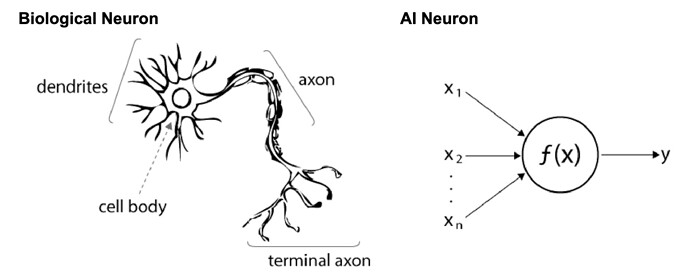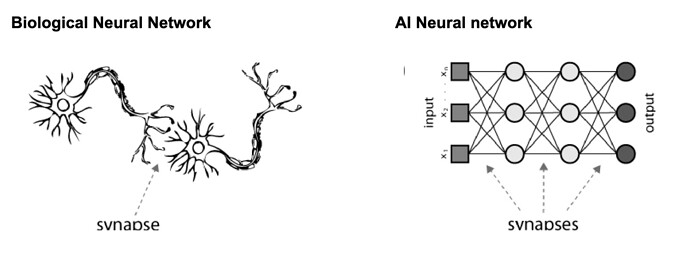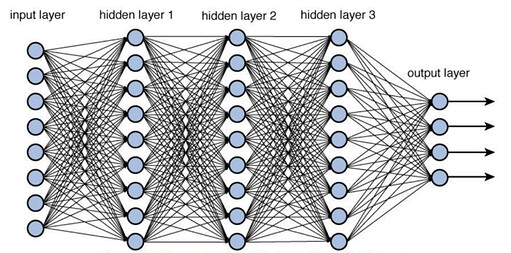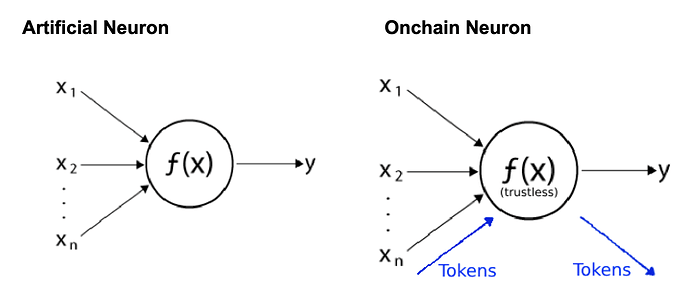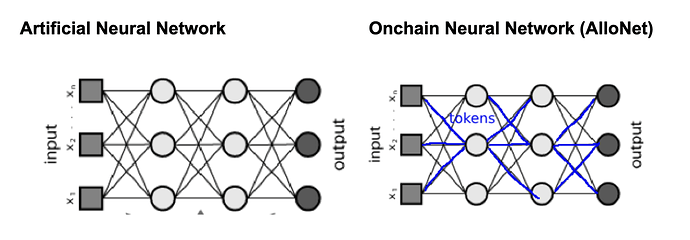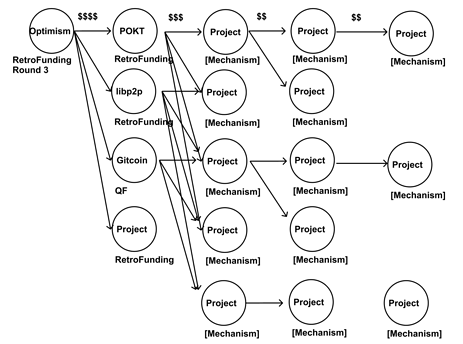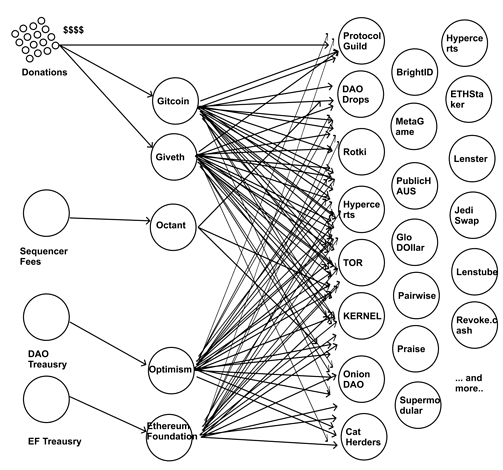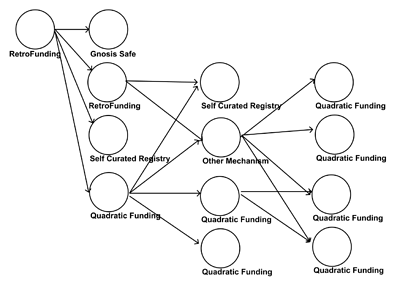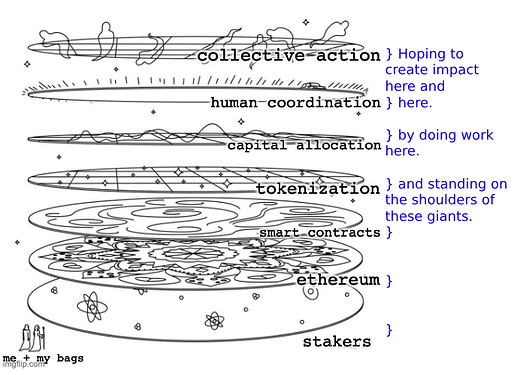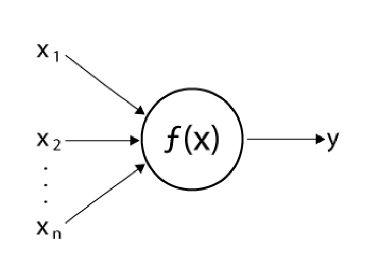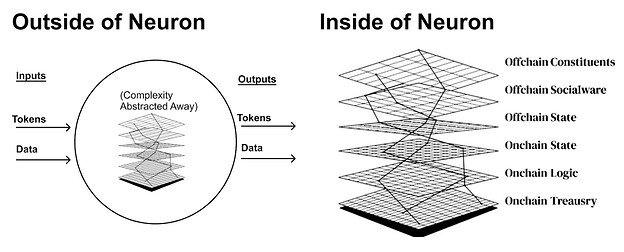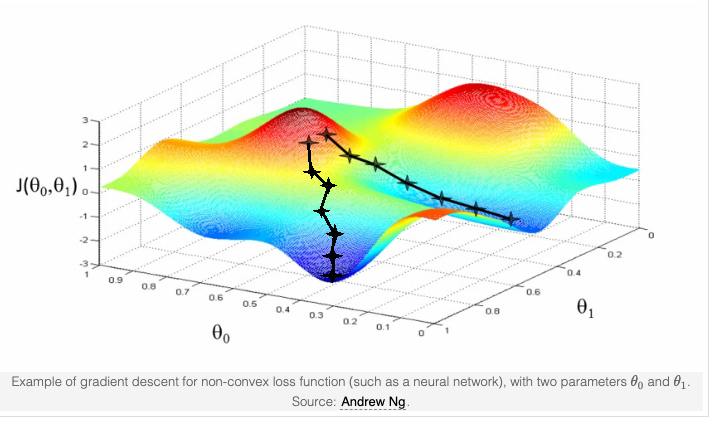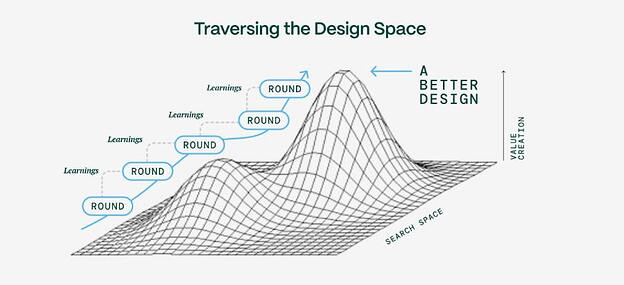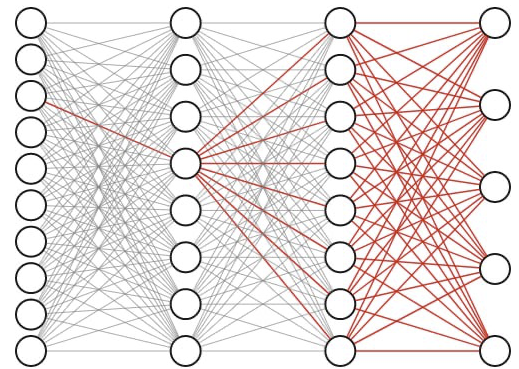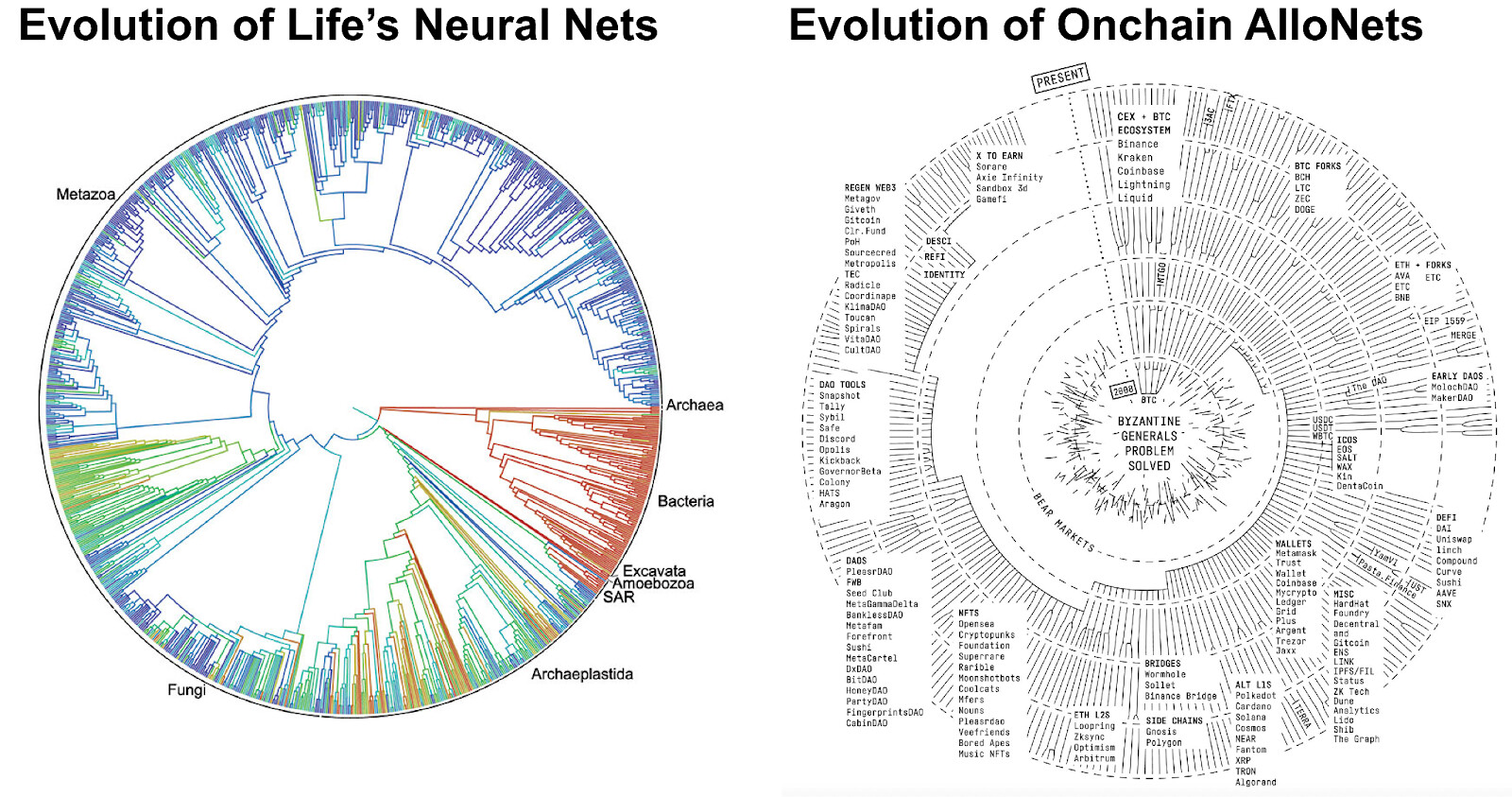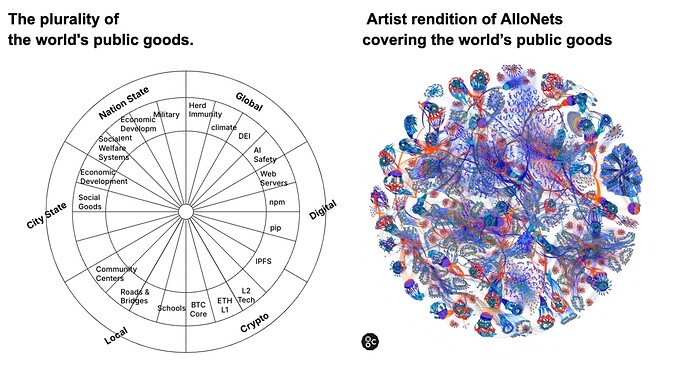[Thanks to Carl Cervone, MathildaDV, Feems, Tayken, Izzy + others for reading drafts of this post!]
Onchain Capital Allocation Neural Networks (AlloNets)
A Powerful Approach to Manfesting Collective Action in an Onchain World
TLDR
- Neural networks excel at recognizing patterns and making predictions from complex, high-dimensional data.
- The post draws on lessons from neural networks to reason about how the interconnected, adaptive nature of neural networks can inspire more efficient decision-making and resource distribution in onchain ecosystems.
- We coin the phrase onchain capital allocation neural networks (AlloNets).
- AlloNets could be well-positioned to optimize capital distribution in complex sociopolitical ecosystems, with important goals like fueling public goods funding, collective action, and/or ecosystem growth.
Table of Contents
- Prerequisite Knowledge
- Introduction
- From Biological Neural Networks to AI Neural Networks: The Evolution of Intelligent System
- AlloNets: The Emergence of a New Paradigm
- AlloNets: Real World Examples
- AlloNets: The Potential
- Conclusion
- Appendix
Prerequisite Knowledge
This post assumes a basic knowledge of
- neural networks.
- TLDR - Neural networks are computational models inspired by the human brain that learn to recognize patterns and make decisions by adjusting the connections between nodes (neurons).
- If you want to learn more, read this!
- onchain capital allocation.
- TLDR - Capital allocation is the process of deciding how to spend or invest financial resources
- Bringing capital allocation onchain could enable more democratic, precise, trustless, and scalable capital allocation.
- If you want to learn more, read this!
1. Introduction
In recent years, the development of neural networks has revolutionized the fields of artificial intelligence (AI) and machine learning (ML), bringing unprecedented advancements in data processing, pattern recognition, and decision-making capabilities.
These AI neural networks are inspired by the intricate architecture of biological neural networks, where each neuron processes and transmits information across a complex web of connections.
The interconnected, adaptive nature of neural networks can inspire more efficient decision-making and resource distribution in decentralized systems.
As we explore the principles behind neural networks, we are inspired to see entirely new ways of framing problems that go beyond conventional approaches. One such idea is the concept of onchain capital allocation neural networks (AlloNets), which could offer a novel mental model for decentralized resource distribution by drawing on the problem-solving capabilities found in AI neural networks.
In this post, we will explore the analogy between biological neural networks, AI neural networks, and onchain capital allocation neural networks (AlloNets). We will delve into the parallels between the fundamental units of each system—
- the biological neuron;
- the AI neuron;
- and the onchain neuron (colloquially known as a smart contract)
We explore how neural networks are capable of framing problems & sometimes solving them in complex systems. Ultimately, we will argue that AlloNets hold the promise of optimizing capital allocation & distribution in complex sociopolitical ecosystems, with advanced goals such as fueling public goods funding, collective action, and/or ecosystem growth.
2. From Biological Neural Networks to AI Neural Networks: The Evolution of Intelligent Systems
A. Biological Neural Networks: The Foundation of Inspiration
In the human brain, a neuron is the fundamental unit responsible for processing and transmitting information.
Each neuron receives input from other neurons through dendrites, processes this input within the cell body, and transmits an output signal through its axon to other neurons. The interconnectedness of these neurons forms a vast and intricate network that enables the brain to perform a wide range of cognitive functions, from simple involuntary reflexes to complex decision-making processes.
The power of biological neural networks lies in their ability to process and integrate information from multiple sources, allowing for adaptive and flexible responses to changing environments.
This capability is what inspired the development of artificial neural networks, which seek to mimic the brain’s ability to learn from data and make decisions based on that learning.
B. AI Neural Networks: solving complex problems
AI neural networks are the digital counterparts of biological neural networks.
AI neural networks are simplified, mathematical models inspired by biological neural networks, designed for specific tasks like pattern recognition or data analysis. While biological neural networks are highly complex, adaptive systems capable of general intelligence, learning, and consciousness, AI neural networks are task-specific and lack attributes of consciousness. Both can learn from data, but biological networks do so through experience and evolution, while AI networks require structured training.
In AI, a neuron is a computational unit that takes input, performs a mathematical operation (such as a weighted sum), and produces an output that is passed to the next layer of neurons.
These neurons are organized into layers, with the input layer receiving data, the hidden layers performing intermediate computations, and the output layer generating the final result, often leading to action.
The strength of AI neural networks lies in their ability to process vast amounts of data and identify patterns that may not be immediately apparent to human observers.
Through training techniques such as backpropagation and gradient descent, AI neural networks can learn from data, adjust their internal parameters, and improve their performance over time.
In both biological and AI neural networks, information processing occurs in layers, where each layer extracts increasingly complex features from the input data. In biological systems, sensory inputs like visual or auditory signals are processed through layers of neurons, with early layers detecting simple features (e.g., edges or tones) and deeper layers integrating these into more complex perceptions (e.g., shapes or melodies). Similarly, in AI neural networks, initial layers identify basic patterns in data, while subsequent layers combine these patterns into higher-level abstractions, enabling tasks like image recognition or language processing. This layered approach allows both systems to efficiently process complex information by breaking it down into simpler components.
This architecture has led to remarkable achievements in fields such as image recognition, natural language processing, and autonomous systems.
One of the key features of AI neural networks is their ability to solve complex problems by stacking multiple layers of neurons together, forming what is known as a deep neural network. These deep networks are capable of modeling highly nonlinear relationships and capturing intricate patterns in data, making them well-suited for tasks that require sophisticated decision-making and prediction.
AI systems, through layered neural networks, aim to replicate the adaptive intelligence of biological networks by mimicking the way these natural systems process, learn, and interpret information. While AI is inspired by the structured, layered approach of biological networks, allowing for task-specific pattern recognition and data analysis, it remains a simplified and less flexible counterpart. A goal of AI research is to bridge this gap, striving to create systems that not only perform specific tasks efficiently but also adapt and learn in a manner akin to the dynamic, generalized intelligence found in biological organisms.
3. AlloNets: The Emergence of a New Paradigm
As the world of blockchain and DAOs continues to grow, we are beginning to see the emergence of a new type of computational unit: the smart contract.
Smart contracts are a self-executing piece of code that resides on a blockchain and performs specific actions based on predefined rules.
Smart contracts, when framed through the lens of neural networks, can be seen as an onchain neuron.
Just as AI neurons process/transmit information within a neural network, onchain neurons process/transmit information AND value within a decentralized network.
The flexibility and programmability of smart contracts make them ideal candidates to be onchain neurons, as they can be tailored to execute a wide range of actions, from simple token transfers to sophisticated governance mechanisms.
Onchain neurons are the atomic units of what can be termed as onchain capital allocation neural networks (AlloNets).
AlloNets are composed of multiple smart contracts that work together to allocate capital across a decentralized ecosystem. By stacking these smart contracts together, it is possible to create complex networks capable of optimizing capital distribution based on a variety of factors, such as market conditions, onchain/online user behavior, and community governance.
The architecture of an AlloNet draws a direct lineage from AI neural networks.
Just as AI networks are designed to solve complex computational problems, AlloNets are evolving to solve complex financial and governance problems - like upgrading public goods funding, driving ecosystem growth, creating collective action, and enabling decentralized governance.
We cover more about how AlloNets are trained in the appendix.
4. AlloNets: Real World Examples
AlloNets are more than theoretical; they are in use today.
Example A. Optimism RetroFunding
One example of AlloNet in action is the Retro Funding ecosystem, driven by Optimism’s recent $100m+ distribution of funding to ecosystem public goods—many of which were forward propagated through a network of projects + contributors in the Ethereum ecosystem…
libp2p and POKT, for example, took the funds they received from OP Retro Funding and ran their own RetroFunding Rounds.
The propagation of tokens through this ecosystem obviously visually resembles an AlloNet—each project acts as a neuron, propagating the funds forward (or not) based upon the rules embedded in its own locality.
Example B. Ethereum Ecosystem
Zooming out to the entire Ethereum space, we can see that larger AlloNets have emerged across the ecosystem.
Here is what it looks like in web3 public goods funding in 2023:
(image above is only a representative sample because the AlloNet is too large!- checkout the high res view in all of its glory!)
How does this AlloNet network find optimal configuration? Each project in this AlloNet acts as a neuron, propagating the funds forward (or not) based upon the rules embedded in its own locality. Different localities of the network have differing rules, constituents, and agendas, but they each common information sources, smart contracts, and memetic schelling points (“public goods are good”, fund what matters) that inform their outcomes.
We cover more about how AlloNets are trained in the appendix.
Types of real-world onchain neurons
The tokens sent to these projects were forward propagated through the AlloNet by different smart contracts (what we’d call neurons in the context of a neural network architecture)…
Here are some examples of onchain neurons used in these examples:
- Gnosis Safe: A multi-signature wallet that requires a specified number of approvals from designated signers to execute a transaction, ensuring that capital allocation decisions are made collaboratively.
- Compound’s Governance: A protocol where token holders can vote on proposals that determine how funds in the protocol are allocated, such as adjusting interest rates or distributing liquidity incentives.
- MolochDAO: A DAO framework where members can propose how to allocate shared resources, with proposals approved through member voting and funds distributed according to the collective decision.
- Gitcoin Grants: An ecosystem utilizing quadratic funding, where community members contribute to projects they support, and the total funding is matched from a central pool based on the number of contributors, not just the total amount raised.
- EasyRetroFunding.xyz: A retroactive public goods funding tool that allows communities to allocate funds to projects based on their past contributions. Through decentralized voting, the community retrospectively rewards initiatives that have delivered significant value, incentivizing long-term impact.
- many more examples! Anything that can input tokens/data and output a distribution of tokens is a “neuron” in this emergent AlloNet. Read more here.
Each of these neurons allocates resources in an opinionated way, with allocation methodologies that can be very different from each other neuron to neuron.
For example,
- Retroactive funding rewards DAOs or projects based on their proven impact, which is evaluated after the fact.
- Quadratic funding, on the other hand, amplifies the collective decision-making process by matching contributions from a larger pool, giving more weight to widely-supported projects.
While each neuron may have a different allocation methodology, each neuron shares the basic function of receiving, allocating, and distributing tokens, so together the neurons compose to form a neural network.
In addition to each neuron having it’s own allocation methodology, each neuron also has its own constituency that governs that neuron. This is in contrast to how AI neural networks work, where a global state and optimisation function trains the network. There are some other important differences in how the AlloNet is trained relative to how traditional AI Neural Networks are trained. We highlight these differences in the appendix section, “Differences in training AI neural networks vs onchain neural networks”.
We cover more onchain neurons in AlloNets in more depth in the appendix.
5. AlloNets: The Potential
The potential benefits of AlloNets are significant. By combining complementary properties of blockchains and neural networks, we have a novel but solid foundation for solving complex 21st century problems.
| Blockchains | Neural Networks | |
|---|---|---|
| Good at | Global, transparent, incorruptible, programmable, stateful, consensus | recognizing patterns in complex data |
As more money is routed through AlloNets, it is likely that AlloNets will continue to spin off more data. Neural networks are particularly effective in solving problems in domains where there is a lot of data and where patterns or relationships can be learned from that data.
The density of data emitted by blockchain networks will give AlloNet a significant tailwind. AlloNet will evolve based on this data, but also learn from the careful stewardship of the onchain neurons by their maintainers. They will also be guided by market pressures and advancements in technologies.
It is likely that these networks will become more sophisticated and capable of handling increasingly complex tasks. This could lead to a new era of capital allocation, where resources are elegantly distributed in a more efficient, transparent, and effective manner.
The potential applications of AlloNets are vast and varied. As more data is brought onchain, AlloNets can be used to solve complex socio political problems ranging from fueling public goods funding, collective action, and/or ecosystem growth.
One of the most promising use cases is the optimization of capital distribution within, and between, DAOs… especially in the following domains:
Public Goods Funding: In traditional economic systems, funding for public goods (such as infrastructure, education, and healthcare) is typically managed by centralized authorities, such as governments or large corporations. However, these centralized systems often suffer from inefficiencies, lack of transparency or interoperability, and misallocation of resources. AlloNet offer an elegant alternative, where funding decisions are made by a network of smart contracts based on predefined criteria and community input. This approach has the potential to improve transparency, reduce inefficiencies, and ensure that resources are precisely allocated to projects that truly benefit the community.
Ecosystem Growth: In the context of blockchain ecosystems, capital allocation is a critical factor in driving growth and innovation. AlloNet can be used to incentivize the development of new projects, reward contributors, and ensure that resources are distributed in a way that aligns with the long-term goals of the ecosystem. By leveraging the programmability of smart contracts, these networks can dynamically adjust capital allocation based on feedback from the community, ensuring that resources are allocated to the most promising and impactful initiatives at scale.
Decentralized Governance: Decentralized governance is a key feature of many blockchain-based ecosystems, where decisions are made collectively by the community rather than by a centralized authority. AlloNet can play a crucial role in enabling decentralized governance by segmenting, defining, and executing the allocation of resources based on the outcome and processes of those communities… This can help streamline decision-making processes, reduce the risk of manipulation, and ensure that resources are allocated in a way that reflects the will of the community.
Solving Coordination Failures - Coordination failure occurs when individuals or groups are unable to align their actions or decisions, leading to suboptimal outcomes despite the potential for mutual benefit. AlloNet creates new foundations for solving coordination failures by combining the powerful properties of blockchains + neural networks. This approach could minimize the impact of individual biases and central points of failure, fostering better coordination and resource allocation across decentralized networks.
Creating Collective Action - Collective action is the coordinated effort of a group to achieve a common goal or address a shared problem, often overcoming individual self-interest to benefit the group as a whole. AlloNet can create collective action by aligning participants’ incentives and ensuring that contributions are rewarded fairly and transparently. AlloNets enable a group of individuals or entities to pool resources and make decisions collaboratively, with the assurance that funds will be allocated according to predefined rules without the need for centralized control. This reduces the risk of free-riding and encourages active participation, as the system automatically enforces agreed-upon outcomes, making collective action more attractive, feasible, and scalable.
Resilience and Adaptability: One of the key advantages of AlloNet is their ability to adapt to changing conditions and evolve over time. Just as AI neural networks can learn from data and improve their performance, AlloNet can be programmed to respond to changes in market conditions, user behavior, and other external factors. This adaptability makes them well-suited for dynamic and rapidly evolving environments, where traditional capital allocation methods may struggle to keep pace.
A key opportunity as AlloNets grow is in economies of scale. The opportunity for an individual project to be influenced or funded by many different “neurons” will grow as more data and value flows through these networks. There is a network effect at work here. As more contributors contribute, more projects get funded. As more projects get funded, more contributors are drawn. This virtuous, positive-sum cycle repeats ad infinitum.
An early example of this is Protocol guild. Protocol guild has been funded by multiple neurons (Ethereum Foundation, Uniswap, ENS (Ethereum Name Service), Optimism, Balancer)
As more and more projects begin allocating capitalfor their own ecosystem public goods, there will be opportunities to pinch off 1-10% of funding here and there for upstream public goods funding. While these amounts may be negligible to each individual contributor, through the economy of scale, they may become significant to the receivers.
While the potential for AlloNets are immense, we are still a long way from realizing these benefits. The examples above are currently a very small share of the actual allocation work happening on Ethereum. We also don’t have good abilities for measuring the quality or outcome achieved by AlloNets. Instead, we put capital in and see what comes out the other side. It’s still early days!
6. Conclusion
By drawing upon lessons from AI neural networks, we can begin to envision a future where decentralized networks optimize capital distribution in complex sociopolitical ecosystems. The concept of AlloNets represent a promising convergence of ideas from biology, AI, and blockchain technology.
These networks have the potential to solve complex problems, upgrade public goods funding, drive ecosystem growth, create collective action, and enable decentralized governance, all while adapting to changing conditions and evolving (as biological systems do) over time.
However, realizing this vision will require overcoming significant challenges related to complexity, security, scalability, fragmentation, governance, and ethics—challenges we cover in the appendix below. If we solve these problems, we can unlock new opportunities for decentralized finance and governance, and pave the way for a more coordinated, egalitarian future.


